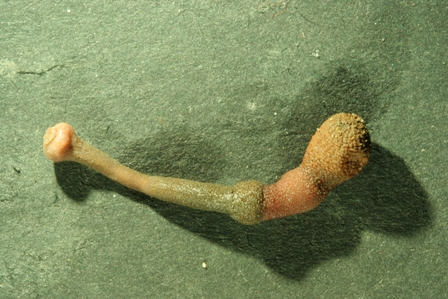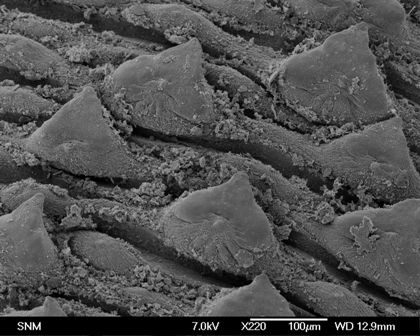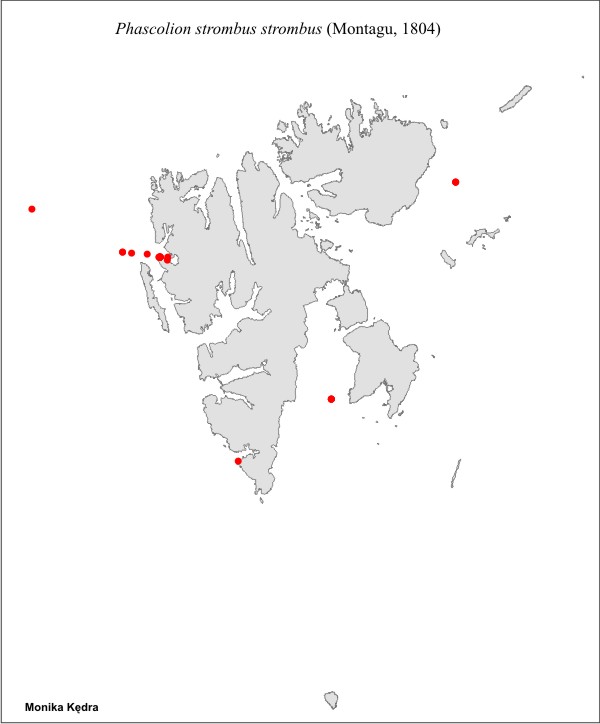Phascolion strombus strombus (Montagu, 1804)
A cosmopolitan species often found in mollusk shells and polychaete tubes

Phascolion strombus |

Phascolion strombus: papillae |

|
Sipunculus strombus Montagu, 1804
Phascolion strombi Théel, 1875
Distinguishing characteristics
Two retractors: ventral retractor much thinner then dorsal.
Holdfast papillae V-shaped with dark hardened border.
Sharp, clawlike hooks.
10-30 well-developed tentacles present on the introvert.
An aggregation of large papillae around the anterior end of the trunk.
Trunk length 30-40 mm (usually 5-20 mm).
Some worms lack hooks, probably due to predation and regeneration of introvert.
There is an extreme plasticity of form of this very widespread and common species.
Size
Common trunk length: 5-15 mm
Maximum trunk length: 30-40 mm
Color
Grey, brown, yellowish, reddish
Habitat
Inhabits sand, mud, silt, often found in mollusk shells and polychaete tubes
Feeding
deposit feeder
Life cycle
Freely spawn gametes into the water
A short-term lecithotrophic trochophore larva
Usually, after settlement they do not disperse a lot
More Biology & Ecology
Phascolion strombus uses empty mollusc shells, polychaete tubes and foraminiferan tests as a shelter. They are semimobile, mostly epibenthic worms holding empty shells and tubes and collecting sediments with tentacles. The density of this ecological group tends to be limited by a number of available empty shells and tubes. Its distribution is determined by the sediment type: it avoids soft clay as the irrigation than is impossible due to clogging of the apertures.
Distribution
Very common and eurytopic in the North Atlantic and Arctic oceans; known from depths of 1 - 4030 m.
References
- Cutler EB (1973) Sipuncula of the western north Atlantic. Bulletin of the American Museum of Natural History 152:103-204
- Cutler EB (1977) Scientific results of the Danish Deep-Sea Expedition round the world 1950-52. Galathea Report 14:135-157
- Cutler EB (1994) The Sipuncula. Their Systematics, Biology, and Evolution. 1-453
- Cutler EB, Cutler NJ (1985) A revision of the genera Phascolion, Théel, and Onchnesoma Koren and Danielssen (Sipuncula). Proceedings of the Biological Society of Washington 98:809-850
- Fischer W (1895) Die Gephyreen des Naturhistorschen Museums zu Hamburg. Abhaltungen aus dem Gebiet der Naturwissenschaften (Hamburg) 13:1-24
- Fischer W (1922a) Gephyreen der Arkischen Meere. Wissenschaftliche Meeresuntersuchungen Abteilung Helgoland 13:229-246
- Fischer W (1922b) Gephyreen des Reichsmuseums zu Stockholm. Archiv für Zoologi 14:1-39
- Fischer W (1929) Die Sipunculiden, Priapuliden und Echiuren der Arktis. 5
- Gibbs PE (1978) Menestho diaphana (Gastropoda) and Montacuta phascolionis (Lamellibranchia) in association with the sipunculan Phascolion strombi in British waters. Journal of the Marine Biological Association of the United Kingdom 58:683-685
- Gibbs PE (1985) On the genus Phascolion (Sipuncula) with particular reference to the north-east Atlantic species. Journal of the Marine Biological Association of the United Kingdom 65:311-323
- Gibbs PE (2001) Sipunculans. Key and Notes for the Identification of British Species, Synopses of the British Fauna (New Series). Crothers J.H.// Hayward P.J.
- Gibbs PE, Cutler EB (1987) A classification of phylum Sipuncula. Bulletin of the British Museum Natural History Zoology 52:43-58
- Hylleberg J (1970) Fauna associated with the sipunculid Phascolion strombi (Montagu), especially the parasitic gastropod Menestho diaphana (Jeffryes). Ophelia 7:257-276
- Hylleberg J (1975) On the ecology of the Sipunculan Phascolion strombi (Montagu). Proccedings of the International Symposium on the Biology of the Sipuncula and Echiura, Kotor 241-250
- Kędra M, Murina GV (2007) The sipunculan fauna of Svalbard. Polar Research 26:37-47
- Kędra M, Wćodarska-Kowalczuk M (2008) Distribution and diversity of sipunculan fauna in high Arctic fjords (west Spitsbergen). Polar Biology 31:1181-1190 Pancucci-Papadopoulou MA, Murina GV, Zenetos A (1999) The phylum Sipuncula in the Mediteranean Sea. 1-109
- Wesenberg-Lund E (1930) Priapulida and Sipunculidae. Danish Ingolf-Expedition 4:1-44
- Wesenberg-Lund E (1933) The collections of Gephyreans in the Royal Museum of Natural History of Belgium. Bulletin du Institute Royal des Sciences Naturelles de Belgique 9:1-15
- Wesenberg-Lund E (1937a) Gephyrea :The zoology of Iceland. 2:1-17
- Wesenberg-Lund E (1937b) The zoology of east Greenland: Gephyreans. Meddelelser om Gronland 121:1-25
- Wesenberg-Lund E (1938a) Norwegian Gephyrea from the collections of the Zoological Museum of Trondheim. Det Kongelige Norske Videnskabers Selskabs Forhandlinger 11:26-29
- Wesenberg-Lund E (1938b) The Godthaab Expedition 1928. Gephyrea. Meddelelser om Gronland 79:1-29
- Wesenberg-Lund E (1939) Gephyreans from Swedish waters in the Museum of Natural History of Gothenburg. Göteborgs Kungliga Vetenskaps Vittenhets-Samhälles Handlingar 6:1-35
